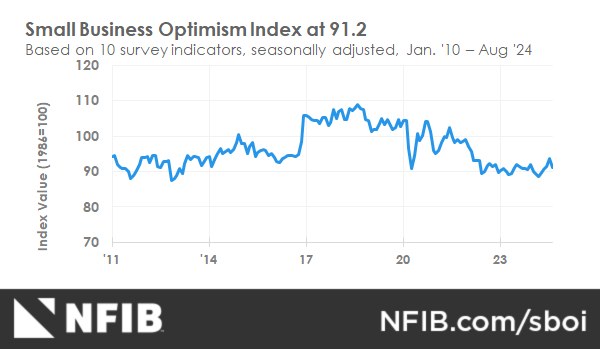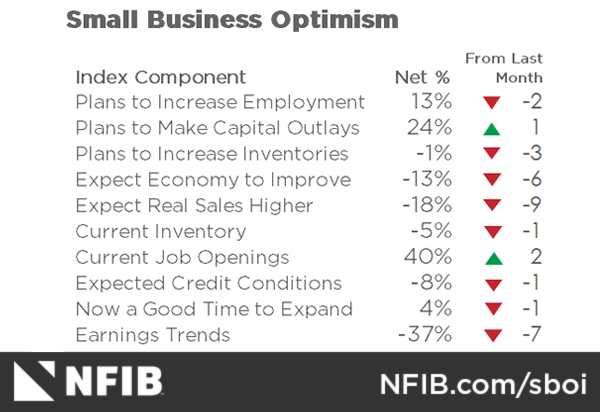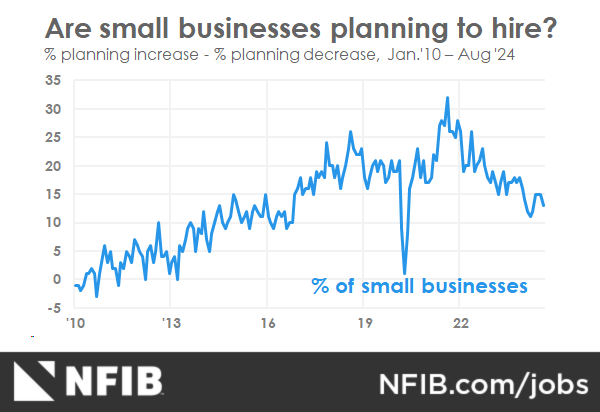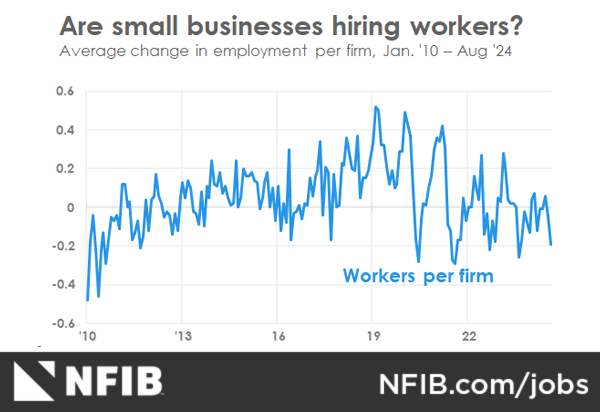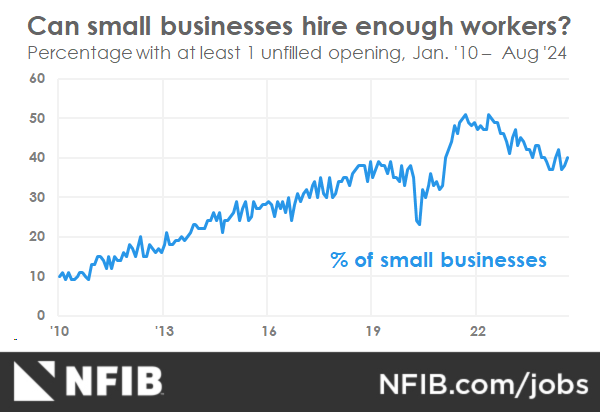The NFIB Research Foundation has collected Small Business Economic Trends data with quarterly surveys since the 4th quarter of 1973 and monthly surveys since 1986. Survey respondents are drawn from NFIB’s membership. The report is released on the second Tuesday of each month. This survey was conducted in August 2024.
Small Business Optimism Index
August 2024 Report:
Small Business Optimism Dips in August
The NFIB Small Business Optimism Index fell by 2.5 points in August to 91.2, erasing all of July’s gain. This is the 32nd consecutive month below the 50-year average of 98. The Uncertainty Index rose to 92, its highest level since October 2020. Inflation remains the top issue among small business owners, with 24% of owners reporting it as their top small business operating issue, down one point from July.
“The mood on Main Street worsened in August, despite last month’s gains,” said NFIB Chief Economist Bill Dunkelberg. “Historically high inflation remains the top issue for owners as sales expectations plummet and cost pressures increase. Uncertainty among small business owners continues to rise as expectations for future business conditions worsen.”
Key findings include:
- The frequency of reports of positive profit trends was a net negative 37% (seasonally adjusted), seven points worse than in July and the lowest since March 2010.
- Twenty-four percent of owners reported inflation as their single most important problem in operating their business, down one point from July.
- The net percent of owners expecting higher real sales volumes fell nine points in August to a net negative 18% (seasonally adjusted). Real sales volume expectations were the largest contributor to the decline in the Optimism Index along with earning trends and expected business conditions.
- A seasonally adjusted net 20% plan to raise compensation in the next three months, up two points from July.
- The net percent of owners raising average selling prices fell two points from July to a net 20% seasonally adjusted.
As reported in NFIB’s monthly jobs report, a seasonally adjusted 40% of all small business owners reported job openings they could not fill in their current period, up two points from July. Of the 62% of owners hiring or trying to hire in August, 90% reported few or no qualified applicants for the positions they were trying to fill.
Fifty-six percent of owners reported capital outlays in the last six months, up two points from July. Of those making expenditures, 40% reported spending on new equipment, 21% acquired vehicles, and 18% improved or expanded facilities. Eleven percent spent money on new fixtures and furniture and 5% acquired new buildings or land for expansion. Twenty-four percent (seasonally adjusted) plan capital outlays in the next six months, up one point from July.
A net negative 16% of all owners (seasonally adjusted) reported higher nominal sales in the past three months. The net percent of owners expecting higher real sales volumes fell nine points to a net negative 18% (seasonally adjusted).
The net percent of owners reporting inventory gains was unchanged at a net negative 9%, seasonally adjusted. Not seasonally adjusted, 11% reported increases in stocks and 18% reported reductions.
A net negative 5% (seasonally adjusted) of owners viewed current inventory stocks as “too low” in August, down one point from July. A net negative 1% (seasonally adjusted) of owners plan inventory investment in the coming months, down three points from July.
The net percent of owners raising average selling prices fell two points from July to a net 20% seasonally adjusted. Twenty-four percent of owners reported that inflation was their single most important problem in operating their business. Unadjusted, 15% reported lower average selling prices and 34% reported higher average prices.
Price hikes were the most frequent in the finance (52% higher, 3% lower), retail (47% higher, 8% lower), construction (33% higher, 16% lower), and manufacturing (33% higher, 7% lower) sectors. Seasonally adjusted, a net 25% plan price hikes in August.
Seasonally adjusted, a net 33% reported raising compensation, unchanged from July and the lowest reading since April 2021. A seasonally adjusted net 20% plan to raise compensation in the next three months, up two points from July. Nine percent of owners cited labor costs as their top business problem, unchanged from July and only four points below the highest reading of 13% reached in December 2021. Twenty-one percent said that labor quality was their top business problem, remaining behind inflation as the number one issue.
The frequency of reports of positive profit trends was a net negative 37% (seasonally adjusted), seven points worse than in July and the lowest since March 2010. Among owners reporting lower profits, 31% blamed weaker sales, 17% blamed the rise in the cost of materials, 13% cited labor costs, and 10% cited lower selling prices. For owners reporting higher profits, 45% credited sales volumes, 35% cited usual seasonal change, and 10% cited higher selling prices.
Three percent of owners reported that all their borrowing needs were not satisfied. Twenty-six percent reported all credit needs met and 60% said they were not interested in a loan. A net 7% reported their last loan was harder to get than in previous attempts.
Four percent of owners reported that financing was their top business problem in August, up one point from July.
The NFIB Research Center has collected Small Business Economic Trends data with quarterly surveys since the fourth quarter of 1973 and monthly surveys since 1986. Survey respondents are randomly drawn from NFIB’s membership. The report is released on the second Tuesday of each month. This survey was conducted in August 2024.
LABOR MARKETS
In NFIB’s August survey, 40 percent (seasonally adjusted) of all owners reported job openings they could not fill in the current period, up 2 points from July. Thirty-six percent have openings for skilled workers (up 4 points) and 15 percent have openings for unskilled labor (down 1 point). The difficulty in filling open positions is particularly acute in the transportation, construction, and manufacturing sectors. Job openings in construction were up 5 points from last month and over half of the firms (60 percent) have a job opening they can’t fill. Openings were the lowest in the agriculture and finance sectors. A seasonally adjusted net 13 percent of owners plan to create new jobs in the next three months, down 2 points from July. Overall, 62 percent reported hiring or trying to hire in August, up 5 points from July. Fifty-six percent (90 percent of those hiring or trying to hire) of owners reported few or no qualified applicants for the positions they were trying to fill (up 7 points and the highest since September 2023). Thirty-one percent of owners reported few qualified applicants for their open positions (up 2 points) and 25 percent reported none (up 5 points). Reports of labor quality as the single most important problem for business owners rose 2 points from the previous month to 21 percent. Labor cost reported as the single most important problem for business owners was unchanged at 9 percent.
CAPITAL SPENDING
Fifty-six percent reported capital outlays in the last six months, up 2 points from July. Of those making expenditures, 40 percent reported spending on new equipment (up 4 points), 21 percent acquired vehicles (down 1 point), and 18 percent improved or expanded facilities (up 3 points). Eleven percent spent money on new fixtures and furniture (up 1 point) and 5 percent acquired new buildings or land for expansion (down 2 points). Twenty-four percent (seasonally adjusted) plan capital outlays in the next six months, up 1 point from July. A more positive view of the future economy and economic policy would help stimulate longer term investment spending, but currently owners’ views about the future are not supportive and financing costs are very high. Investment is needed to address labor supply chain problems which still persist in the current environment.
INFLATION
The net percent of owners raising average selling prices fell 2 points from July to a net 20 percent seasonally adjusted. Twenty-four percent of owners reported that inflation was their single most important problem in operating their business (higher input and labor costs), down 1 point from July. Unadjusted, 15 percent (up 2 points) reported lower average selling prices and 34 percent (down 2 points) reported higher average prices. Price hikes were most frequent in the finance (52 percent higher, 3 percent lower), retail (47 percent higher, 8 percent lower), construction (33 percent higher, 16 percent lower), and manufacturing (33 percent higher, 7 percent lower) sectors. Seasonally adjusted, a net 25 percent plan price hikes in August (up 1 point).
CREDIT MARKETS
Three percent of owners reported that all their borrowing needs were not satisfied, up 1 point from July. Twenty-six percent reported all credit needs met (up 1 point) and 60 percent said they were not interested in a loan (down 2 points). A net 7 percent reported their last loan was harder to get than in previous attempts (up 1 point). Overall, credit markets remain friendly toward small businesses. Four percent reported that financing was their top business problem in August (up 1 point). A net 15 percent of owners reported paying a higher rate on their most recent loan, unchanged for the third consecutive month. The average rate paid on short maturity loans was 9.5 percent, up 0.1 of a point from July. Twenty-seven percent of all owners reported borrowing on a regular basis, unchanged from July.
COMPENSATION AND EARNINGS
Seasonally adjusted, a net 33 percent reported raising compensation, unchanged from July and remaining the lowest reading since April 2021. A seasonally adjusted net 20 percent plan to raise compensation in the next three months, up 2 points from July. The frequency of reports of positive profit trends was a net negative 37 percent (seasonally adjusted), 7 points worse than in July and the lowest since March 2010. Among owners reporting lower profits, 31 percent blamed weaker sales, 17 percent blamed the rise in the cost of materials, 13 percent cited labor costs, and 10 percent cited lower selling prices. For owners reporting higher profits, 45 percent credited sales volumes, 35 percent cited usual seasonal change, and 10 percent cited higher selling prices.
SALES AND INVENTORIES
A net negative 16 percent of all owners (seasonally adjusted) reported higher nominal sales in the past three months, unchanged from July. The net percent of owners expecting higher real sales volumes fell 9 points to a net negative 18 percent (seasonally adjusted). Real sales volume expectations were the largest contributor to the decline in the Optimism Index. The net percent of owners reporting inventory gains was unchanged at a net negative 9 percent, seasonally adjusted. Not seasonally adjusted, 11 percent reported increases in stocks (unchanged) and 18 percent reported reductions (up 1 point). A net negative 5 percent (seasonally adjusted) of owners viewed current inventory stocks as “too low” in August, down 1 point from July. A net negative 1 percent (seasonally adjusted) of owners plan inventory investment in the coming months, down 3 points from July (more plan to draw down stocks than add to them).
COMMENTARY
The last two months have been wrought with political turmoil in the U.S. But on Main Street, it seems to be business as usual. No major change in owner optimism as the Optimism Index remains well below the 50-year average. The outlooks for sales and business conditions are at historically low levels and continue to get worse. Consumer sentiment (Survey of Consumers, Univ. of Mich.) continues to drift lower, but consumer spending resists joining the “slowdown” parade. Manufacturing remains weak and housing and construction are catching its slowdown. Inflation is closer to 2 percent but not there. However, it is close enough for the Federal Reserve to commit to starting interest rates cuts. Reports of price and wage hikes are falling in frequency but remain historically on the high side with plenty of room to fall. Government spending and hiring remain strong, the “legs” of any fourth quarter growth that might occur.
The Uncertainty Index rose to its highest level since October 2020 (98), rising 2 points from July to 92, 19 points above the January reading and 10 points above June. Clearly, “uncertainty” has been on the rise! The Fed’s commitment to cut interest rates should have been a calming factor, so it’s probably not to blame. Aggregate spending and inflation have been fairly stable, but reports of the net percent with higher sales now rivals what was last seen in the 2020 and 2008 recessions. And the stock market is expressing some unease. Internal strife over foreign policy is strengthening, “family fights,” and the election is just weeks away. Expect more volatility in everything in the coming months.
